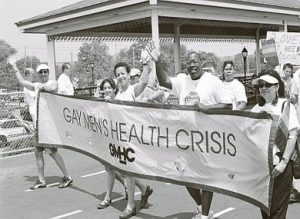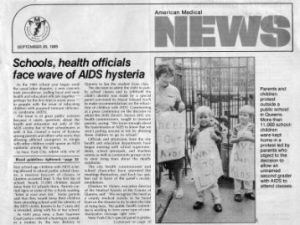The AIDS crisis is an example of how the lack of a “spectacle” disaster narrative can compound the damage inflicted by such an event. In downplaying the severity of the disease, the Reagan Administration facilitated an environment where those most impacted by AIDS faced an uncaring and unsympathetic public; as a result, gay men throughout the country were forced to fundraise, raise awareness, and even attempt to treat the disease without the help of the federal government, and, in many cases, the medical industry. Furthermore, the vacuum of information facilitated by the Reagan administration’s silence created a breeding ground for misinformation regarding the disease, which compounded the societal oppression faced by victims. Had AIDS been treated as a “spectacle” by the presiding administration at the height of this crisis, the public would have been more inclined to help AIDS victims, rather than to fear and ostracize them.
One result of Reagan’s silence on AIDS was public indifference to the disease; making AIDS a “spectacle” and, in turn, drumming up public support had to be done without the government’s help. An example of this spectacle creation is in the youth outreach programs by groups such as the Gay Men’s Health Crisis and the National Gay Task Force. These groups would send representatives to schools to educate teens on the dangers of AIDS and facilitate compassion, sympathy, and urgency in the younger generation, with the hope that providing students with an accurate picture of the impact of AIDS would lead to a dissemination of this information in the broader public.

(Source: https://www.advocate.com/news/daily-news/2010/05/20/gmhc-board-clients-discuss-move)
One such event, depicted in a 1985 New York Times article, highlights this process of this spectacle-creation. In the article, Mr. Welsh of the Gay Men’s Health Crisis Group speaks to students in a New York City School about the dangers of AIDS. He shared factual information with students, such as the fact that AIDS was “likely to remain incurable for a long time,” that the “period from diagnosis to death can be from eight months to four years,” and that “AIDS is an incurable fatal disease that most often infects young people” (Alexander). These grim statements were accurate and helped instill a sense of urgency in the audience without playing into the hysteria which was developing around the disease. To address the hysteria surrounding AIDS, Welsh dispelled misinformation that AIDS was a “gay plague,” highlighting the statistics that “more women were now contracting the disease” (Alexander). However, he didn’t shy away from the prevalence of AIDS within the homosexual community, noting how “AIDS is transmitted mostly by anal or oral homosexual sex” (Alexander). Finally, Welsh described rational and vital ways of protecting students from AIDS through the “use of condoms, diaphragms or spermicides” (Alexander).
In painting an accurate picture of what the AIDS crisis looked like, the people it affected, and the urgency with which the crisis needed to be addressed, actors like Welsh helped facilitate AIDS as a spectacle and, as a result, drum up public support for battling the virus. Furthermore, in dispelling rumors about the disease and providing logical and effective methods of preventing infection and spreading, Welsh helped dispel the misinformed hysteria which developed when the vacuum of official government statements on the disease conflicted with the massive death toll and impact AIDS had throughout the country. But had the Reagan administration treated AIDS as the spectacle it truly was and coupled that treatment with fact-based explanations for how to avoid becoming infected with the disease and how to prevent spread, the burden of doing so would have been lifted from the gay community who were already decimated by the disease.
Reagan’s silence on the AIDS epidemic did not reduce the impact of the disease, which was widespread enough in the American public that a “spectacle” narrative was bound to occur. But the vacuum of information created by the Reagan administration’s silence meant this “spectacle” narrative was characterized by widespread hysteria and misinformation. One of the most potent examples of this hysteria was in the 1985 New Jersey movement to bar AIDS victims from attending school out of fear of further contamination; the logical fallacies of this movement are laid out in a sarcasm-laden New York Times article from the same year. It notes how “beyond the normal fear of a terrifying disease, there lurks the specter of sexuality, and even of that most awful kind, homosexuality,” humorously highlighting the extent to which many individuals—starved of information regarding the disease itself—merely associated the disease with the homosexual population most affected and, as a result, applied the same baseless homophobic rhetoric to victims as they did to the gay community as a whole (Reinstein).

(Source: https://www.thebody.com/article/three-decades-of-hivaids-part-two)
Furthermore, the piece highlights the inherent contradiction in parent’s unwillingness to send their children to school with AIDS victims with their lack of sympathy for the victims themselves. “No matter what doctors say,” one line begins, “we don’t know what causes AIDS… we can’t afford to take the slightest chance that our children will be infected” (Reinstein). This paragraph is followed by a contradictory, laugh-inducing sentiment expressed by many conservative voices during the AIDS crisis: “people who have AIDS have brought it on themselves. Lock them up” (Reinstein).
The piece also depicts hysteria outside of spaces the classroom and ungrounded in homophobia. One paragraph describes “equally logical precautions” such as ceasing giving blood out of fear of contamination; “although there is no case on record of any person getting AIDS by giving blood, you can’t be too careful” (Reinstein). The piece ends by stating unironic facts about the disease such as “donating blood carries no danger of contamination,” and urges individuals to stay rational (Reinstein). Such statements may not have been necessary had the government addressed the seriousness of the crisis instead of facilitating a fact-less environment for misinformation to spread.